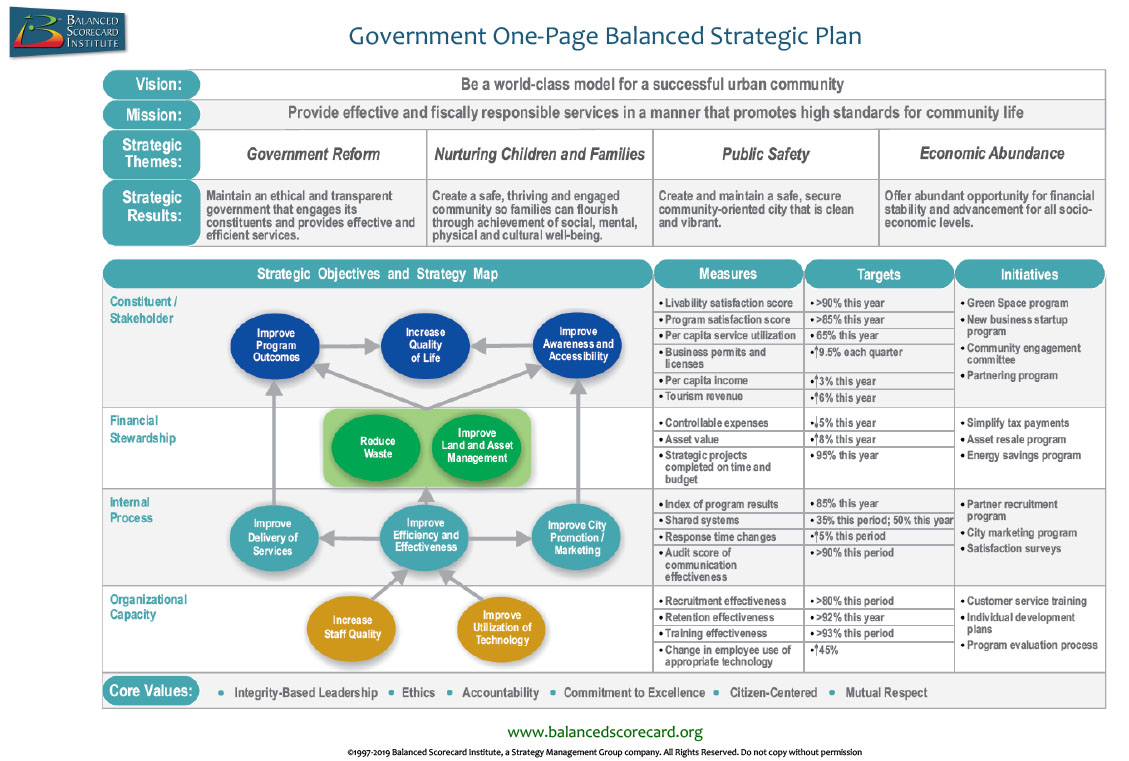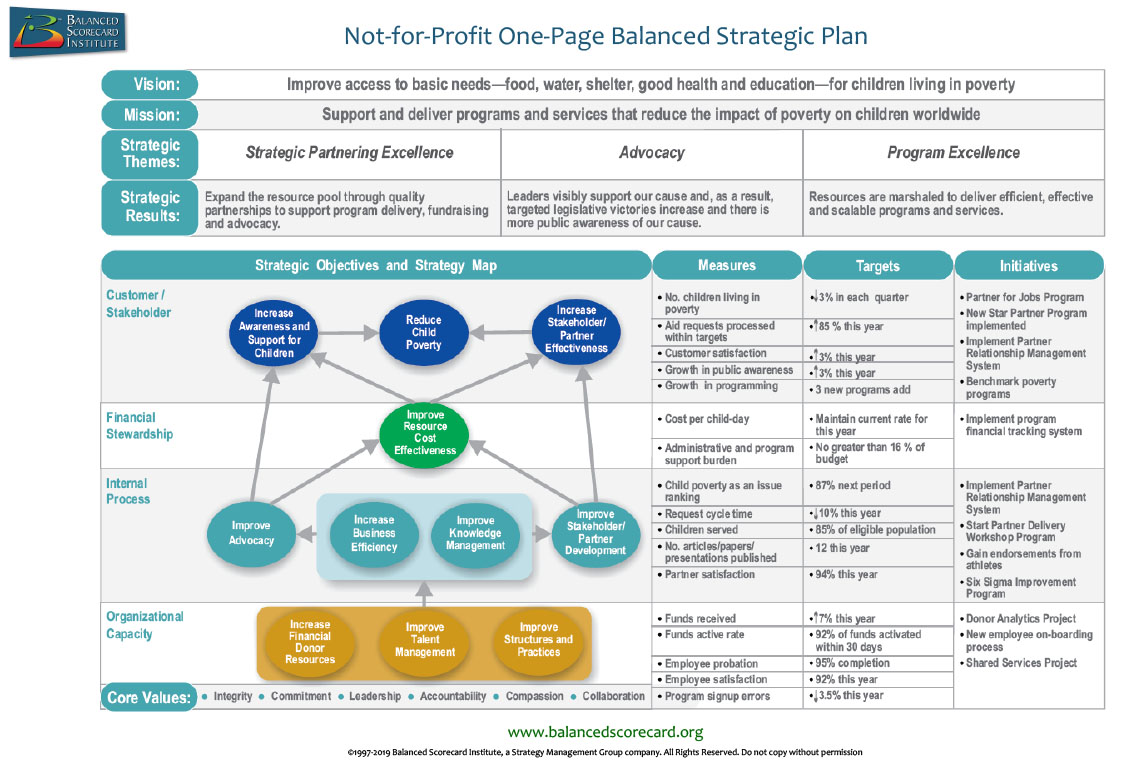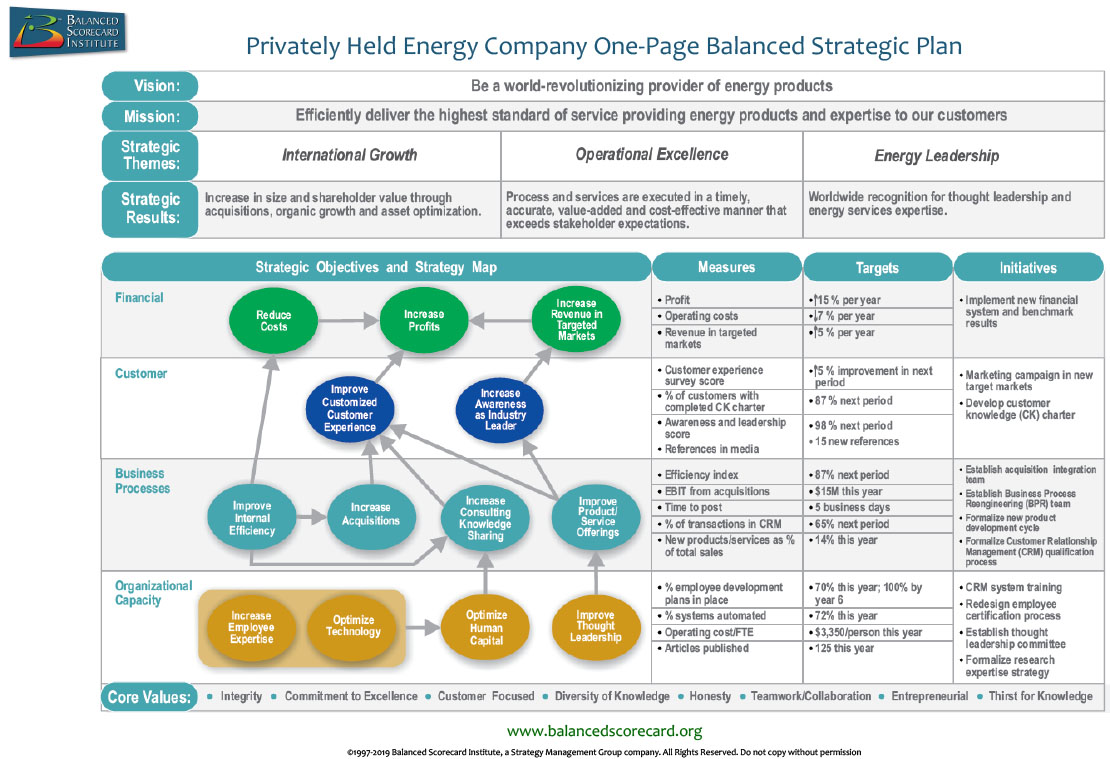Examples & Success Stories
What Organizations Are Successfully Using Balanced Scorecard?
Increasingly, as balanced scorecard (BSC) concepts become more refined, we have had more inquiries asking for examples of organizations that have implemented the BSC, how the BSC applies to a particular business sector, what metrics are appropriate for different sectors, etc. This page provides a database of working balanced scorecard examples that our research has located.
By 2004 about 57% of global companies were working with the balanced scorecard (according to Bain). Much of the information in the commercial sector is proprietary, because it relates to the strategies of specific companies. Public-sector (government) organizations are usually not concerned with proprietary information, but also they may not have a mandate (or much funding) to post their management information on web sites.
Example One-Page Balanced Scorecard Strategic Plan
The One-Page Strategic Plan illustrates how strategy and strategic elements fit together and reinforce each other. This one-page summary graphic includes vision, mission, core values, perspectives, strategic themes & results, strategic objectives, strategy map, performance measures, targets, and strategic initiatives.
Mecklenburg County, NC
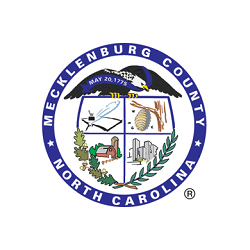 Mecklenburg County lacked a stable and sustainable approach to achieving the vision and it had no consistent model for making funding decisions based on priorities and assessing the bigger impact of those decisions. The County needed to develop a model and structure for decision making that could be sustained regardless of economic conditions or political ideology.
Mecklenburg County lacked a stable and sustainable approach to achieving the vision and it had no consistent model for making funding decisions based on priorities and assessing the bigger impact of those decisions. The County needed to develop a model and structure for decision making that could be sustained regardless of economic conditions or political ideology.
At the time, they had no way of predicting the long-term impact of this decision but the system he implemented led to break-through performance toward achieving the County’s vision and the framework is, to this day, in use at Mecklenburg County. It is an integral part of how the County is managed and has become a model for other municipal governments around the country.
The National Marrow Donor Program®/Be The Match Registry®
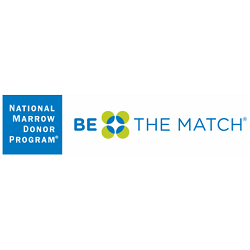 Due to the complexity and overwhelming number of initiatives needed to achieve its vision of 10,000 transplants per year by 2015, it was determined that a new and different way of thinking about the NMDP long-term strategy was needed. The strategic planning system that had been used at NMDP was a fairly well-developed planning process that tracked initiative performance under seven primary areas of strategic focus. While this approach provided a measure of strategic planning for the organization, it was too focused on activities and projects rather than on impacts. And NMDP had to focus on impact if it was going to double its transplant rate to 10,000 per year by 2015.
Due to the complexity and overwhelming number of initiatives needed to achieve its vision of 10,000 transplants per year by 2015, it was determined that a new and different way of thinking about the NMDP long-term strategy was needed. The strategic planning system that had been used at NMDP was a fairly well-developed planning process that tracked initiative performance under seven primary areas of strategic focus. While this approach provided a measure of strategic planning for the organization, it was too focused on activities and projects rather than on impacts. And NMDP had to focus on impact if it was going to double its transplant rate to 10,000 per year by 2015.
Veolia Water North America
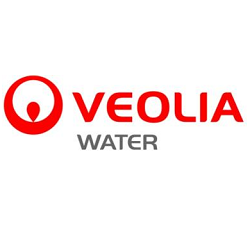 In July 2008, Veolia Water NA gained leadership of the public/private partnership market. At the time, senior management knew they had to overcome some challenges in order to capture growth opportunities. The North American organization was decentralized, with each Regional President acting independently, and the company lacked a unified set of strategies and key performance indicators (KPIs). Senior leadership was convinced that a more formal strategic planning and management system was needed to develop and implement an aggressive growth strategy for Veolia Water NA. As part of the implementation, they also planned to weave the system into an ISO 9000 – focused management framework since the Balanced Scorecard facilitates many of the principles within ISO 90001. Therefore, Strategy Management Group’s training-based approach fit perfectly with Veolia Water NA’s needs.
In July 2008, Veolia Water NA gained leadership of the public/private partnership market. At the time, senior management knew they had to overcome some challenges in order to capture growth opportunities. The North American organization was decentralized, with each Regional President acting independently, and the company lacked a unified set of strategies and key performance indicators (KPIs). Senior leadership was convinced that a more formal strategic planning and management system was needed to develop and implement an aggressive growth strategy for Veolia Water NA. As part of the implementation, they also planned to weave the system into an ISO 9000 – focused management framework since the Balanced Scorecard facilitates many of the principles within ISO 90001. Therefore, Strategy Management Group’s training-based approach fit perfectly with Veolia Water NA’s needs.
Federal Ministry of Health–Ethiopia
 Despite progress to improve the health status of the population, in 2005 Ethiopia’s population still faced a high rate of morbidity and mortality, and the overall health status remained relatively poor. The Ministry of Health was looking for a method to strategically align all of its various tools, programs, processes, and personnel into a comprehensive system that would measurably improve the overall health of the citizens of Ethiopia.
Despite progress to improve the health status of the population, in 2005 Ethiopia’s population still faced a high rate of morbidity and mortality, and the overall health status remained relatively poor. The Ministry of Health was looking for a method to strategically align all of its various tools, programs, processes, and personnel into a comprehensive system that would measurably improve the overall health of the citizens of Ethiopia.
This case study primarily focuses on the recalibration of the FMOH scorecard in 2009-2010, the cascade work performed in 2011-2013, and the break-through improvements that the Ethiopian Health Sector achieved as a result of improved strategic direction and alignment using The Institute Way. In fact, it has been such a success that the Prime Minster of Ethiopia has now mandated that all Ministries in Ethiopia adopt the balanced scorecard as a strategic planning and performance management methodology.
Tolko Industries Ltd.
 Tolko reached out to the Institute for assistance in determining how to measure strategic performance on Tolko’s new strategic plan. After learning more about The Institute Way, Tolko realized that simply aligning incentives to a complex strategic plan was not going to re-energize the company. The employees needed to understand the big-picture strategy, be excited about it, and enthusiastically contribute to both its development and execution.
Tolko reached out to the Institute for assistance in determining how to measure strategic performance on Tolko’s new strategic plan. After learning more about The Institute Way, Tolko realized that simply aligning incentives to a complex strategic plan was not going to re-energize the company. The employees needed to understand the big-picture strategy, be excited about it, and enthusiastically contribute to both its development and execution.
Shat-R-Shield
 CEO Karen Ponce reflects on the company’s balanced scorecard journey and why it “netted more income in 2010 than in the history of the company.”
CEO Karen Ponce reflects on the company’s balanced scorecard journey and why it “netted more income in 2010 than in the history of the company.”
Kenya Red Cross
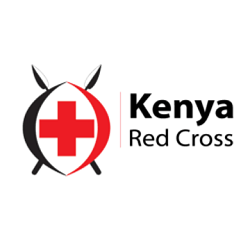 By “revolutionalizing the strategic thinking process,” Kenya Red Cross is now prepared to fulfill their promise to the peopel of Kenya: “Always There.” Read about their experience with the Balanced Scorecard Development Process or View their Scorecard.
By “revolutionalizing the strategic thinking process,” Kenya Red Cross is now prepared to fulfill their promise to the peopel of Kenya: “Always There.” Read about their experience with the Balanced Scorecard Development Process or View their Scorecard.
Douglas County, Colorado
The Douglas County Government shares their “eat the elephant one bite at time” approach for how they strategically aligned their organization from the top floor to the first floor.
U.S. Army Medical Department (AMEDD)
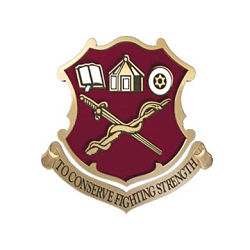 The Army Surgeon General and Commander of the US Army Medical Command champion the use of the balanced scorecard as “the principal tool by which they improve operational and fiscal effectiveness and better meet the needs of patients and stakeholders.”
The Army Surgeon General and Commander of the US Army Medical Command champion the use of the balanced scorecard as “the principal tool by which they improve operational and fiscal effectiveness and better meet the needs of patients and stakeholders.”
Adopters
The following link will take you to our compilation of data on organizations that have reported at least a partial adoption of the balanced scorecard:
Adopters of the balanced scorecard (in alphabetical order of organization name)
Balanced Scorecard Examples
Below we offer links to some files and publications that will show you what the documents and results of balanced scorecards look like. Although these all differ in format and details, they serve to illustrate the visual effectiveness of the balanced scorecard approach to strategic management. (Note: these documents are the products of their respective organizations, not the Balanced Scorecard Institute).
Non-profit Organizations
Oak Knoll Academy – A primer on development of a management strategy for a fictitious private school. A strategy map for the school is also available.
Vinfen Corporation – A private, non-profit human services organization based in Cambridge, MA. They recently published a scorecard and a newsletter that provides details about their strategic plan and performance measures.
Government Organizations
Defense Finance and Accounting Service (DFAS) – Example of a balanced scorecard-based strategic plan for this world-class financial organization, and some additional information about how it was developed (Nov. 2001).
Federal Aviation Administration Logistics Center – A highly customer-focused organization with a balanced scorecard-based strategic plan. Their original plan is a rather large (37 MB) file, so we have removed the graphics and here we provide the text content only, in order to reduce the file size.
Department of Energy Federal Procurement System– One of the early Federal Government adopters of the balanced scorecard. Continues to lead by example with this FY2003 Performance Assessment.
Department of Energy Federal Personal Property Management Program – Example of a balanced scorecard for a major government program.
Government Strategy Map Example – Example of a generic strategy map for a government organization on the Federal, State or local level.
Commercial Organizations
Regional Airline – A strategy map, with objectives, performance measures and initiatives in the balanced scorecard framework.
Credit Card Company – A generic example of a possible strategy map for an innovative credit card company.
If you would like to share your balanced scorecard plans and/or results with the world contact us! .
Contact us to find out how we can help you take your strategy to the next level!


